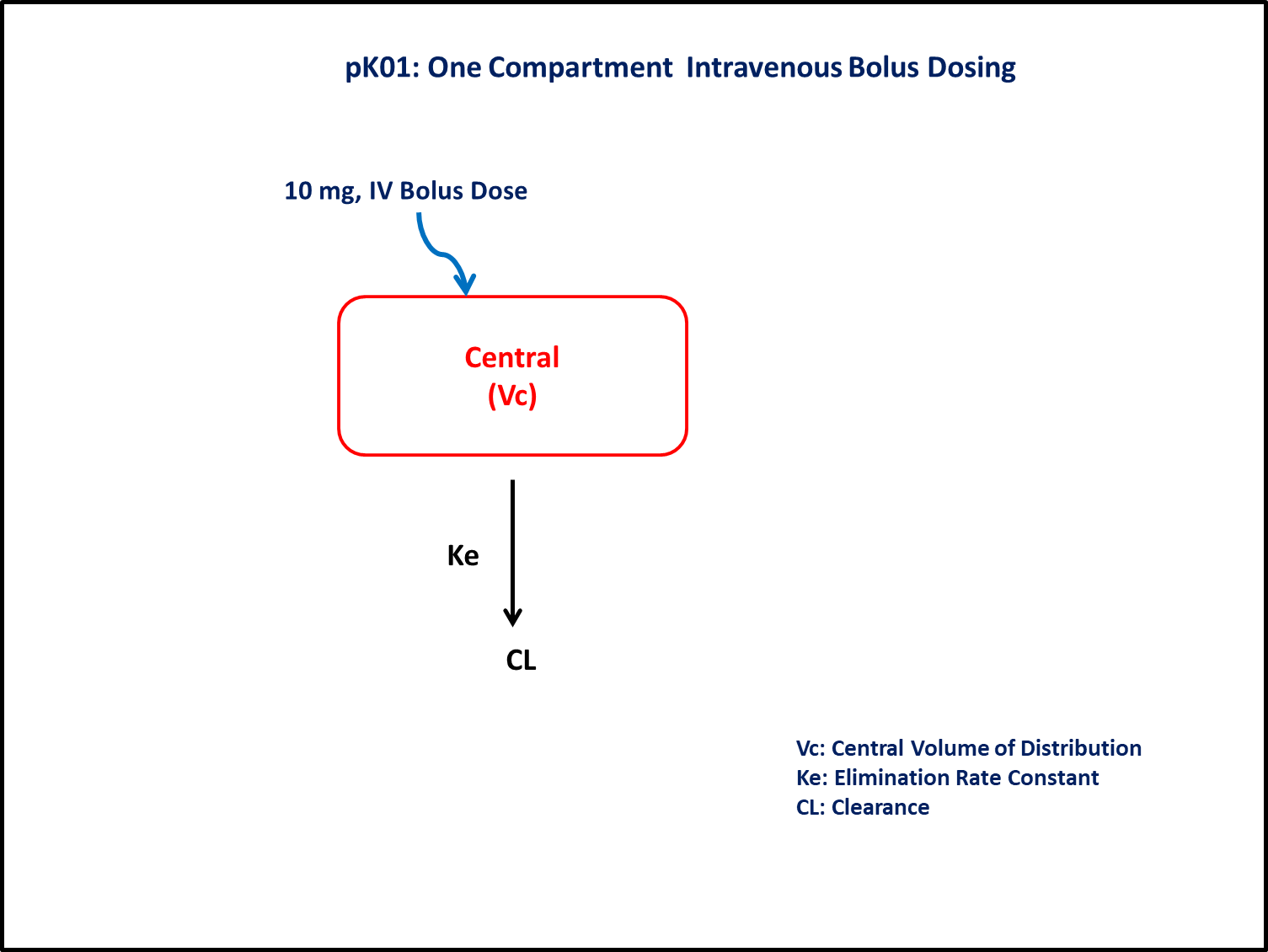using Pumas
using PumasUtilities
using Random
using AlgebraOfGraphics
using CairoMakie
using CSV
using DataFramesMeta
using Dates
PK01 - One-compartment intravenous bolus dosing
1 Learning Outcome
Before constructing a model, it is important to establish the process the model will be following and a scenario for the simulation.
Below is the scenario for this tutorial:
- To build a one compartment model for four subjects given Intravenous bolus dosage.
- To estimate the fundamental parameters involved in building the model.
- To apply differential equation in the model as per the compartment model.
- To design the dosage regimen for the subjects and simulate the plot.
2 Objectives
In this tutorial, you will learn how to build a one compartment model and to simulate the model for four subjects with different disposition parameter estimates.
3 Background
- Structural model - One compartment linear elimination
- Route of administration - IV bolus
- Dosage Regimen - 10 mg IV
- Number of Subjects - 4

4 Libraries
Load the “necessary” libraries to get started.
5 Model
In this one compartment model, intravenous dose is administered into the central compartment.
We account for rate of change of concentration of drug in plasma (Central Compartment) for the time duration up to 150 min.
pk_01 = @model begin
@metadata begin
desc = "One Compartment Model"
timeu = u"minute"
end
@param begin
"""
Clearance (L/hr)
"""
tvcl ∈ RealDomain(lower = 0)
"""
Volume (L)
"""
tvvc ∈ RealDomain(lower = 0)
"""
Additive RUV
"""
σ ∈ RealDomain(lower = 0)
end
@pre begin
Cl = tvcl
Vc = tvvc
end
@dynamics begin
Central' = -(Cl / Vc) * Central
end
@derived begin
"""
PK01 Concentrations (μg/L)
"""
cp = @. 1000 * (Central / Vc)
"""
PK01 Concentrations (μg/L)
"""
dv ~ @. Normal(cp, σ)
end
endPumasModel
Parameters: tvcl, tvvc, σ
Random effects:
Covariates:
Dynamical system variables: Central
Dynamical system type: Matrix exponential
Derived: cp, dv
Observed: cp, dv6 Parameters
In this exercise, parameter estimate values for each subject are different. For each subject, parameters are defined individually, wherein tv represents the typical value for parameters. Parameters provided for simulation are:
Cl- Clearance (L/hr)Vc- Volume of Central Compartment (L)Ω- Between Subject Variabilityσ- Residual error
param_vec = [
(tvcl = 0.10, tvvc = 9.98, σ = 15.80),
(tvcl = 0.20, tvvc = 9.82, σ = 27.46),
(tvcl = 0.20, tvvc = 10.22, σ = 8.78),
(tvcl = 0.20, tvvc = 19.95, σ = 8.50),
]7 Dosage Regimen
To start the simulation process, the dosing regimen specified in the background section must be developed first prior to running a simulation.
The DosageRegimen is specified as 10 mg IV bolus dosage administered to four subjects at time zero.
The concentrations are in μg/L and dose is in mg, thus the final concentration is multiplied by 1000 in the model
ev1 = DosageRegimen(10; time = 0, cmt = 1)| Row | time | cmt | amt | evid | ii | addl | rate | duration | ss | route |
|---|---|---|---|---|---|---|---|---|---|---|
| Float64 | Int64 | Float64 | Int8 | Float64 | Int64 | Float64 | Float64 | Int8 | NCA.Route | |
| 1 | 0.0 | 1 | 10.0 | 1 | 0.0 | 0 | 0.0 | 0.0 | 0 | NullRoute |
This is how to create the population undergoing the dosing regimen above.
ids = [
"1: CL = 0.10, V = 9.98",
"2: CL = 0.20, V = 9.82",
"3: CL = 0.20, V = 10.22",
"4: CL = 0.20, V = 19.95",
]pop = map(i -> Subject(; id = ids[i], events = ev1), 1:length(ids))Population
Subjects: 4
Observations: 8 Simulation
Let’s simulate for plasma concentration for four subjects for specific observation time points after IV bolus dose.
Initialize the random number generator with a seed for reproducibility of the simulation.
Random.seed!(123)The Random.seed! function is included here for purposes of tutorial reproducibility and is not required in the Pumas workflow.
Define the time points at which concentration values will be simulated.
time_points = [10, 20, 30, 40, 50, 60, 70, 90, 110, 150]sim = map(zip(pop, param_vec)) do (subj, p)
return simobs(pk_01, subj, p, obstimes = time_points)
endSimulated population (Vector{<:Subject})
Simulated subjects: 4
Simulated variables: cp, dv9 Visualize results
@chain DataFrame(sim) begin
dropmissing(:cp)
data(_) *
mapping(
:time => "Time (hours)",
:cp => "PK01 Concentration (μg/L)",
color = :id => "",
) *
visual(Lines, linewidth = 4)
draw(;
axis = (; xticks = time_points,),
figure = (; fontsize = 22),
legend = (position = :bottom, nbanks = 2, tellwidth = true),
)
end